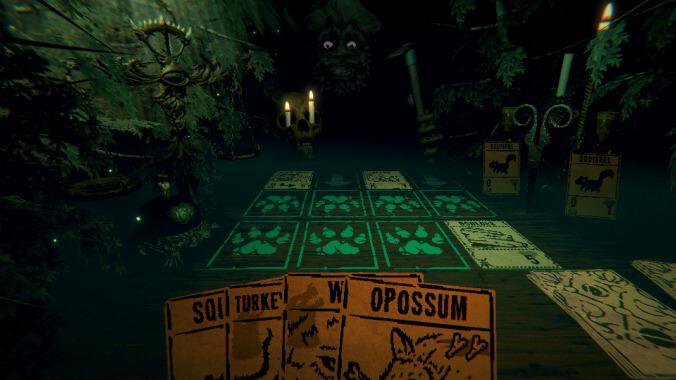In Inscryption—one of the best games of 2021—card battles are serious, scary business
Daniel Mullins’ new title plays in the same spaces as Slay The Spire and Monster Train, but to far darker and more elaborate effect

Obscurity—the real stuff, the cryptic, strange magic that can only fester far from the fluorescent light of day—is a wonderful quality to posses. But it’s a hell of a thing to try to describe.
Which is just part of what makes reviewing Inscryption, the new digital card game from indie developer Daniel Mullins Games, such a potentially fraught task. Mullins’ new game—the follow-up to 2016’s Pony Island and 2018’s The Hex, both twistingly deceptive titles in their own right—is on its surface operating in a familiar genre: The digital deck-building card game.
It’s a now-familiar style of game, one codified by 2017’s Slay The Spire, and refined by more recent titles like Shiny Shoe’s Monster Train. Those games thrived by taking the basic “build a card deck and battle with it” mechanics that made Magic a global, decades-long phenomenon, and then transmuting them into a more traditional video game structure, de-abstracting cards back into actual enemies and attacks.
The core rhythm on display in Inscryption, then, is intimately familiar: You draw the cards. You play the cards. The cards hit each other. And then you repeat until either you, or your foe, are dead.
Except that those other games, great as they are, never went so far as to suggest that you were playing a literal card game, with plenty of pleasantly tactile cards and trinkets within your virtual arm’s reach.
They didn’t set an opponent across from you, urging you to take another move. They also didn’t cloak him in total darkness, save for his sinister, staring eyes—or the hands that reach out to lay down a new card or ring the starting bell for a round…or come across the weathered wooden table to choke the life out of you every time you lose.
If Inscryption was just that—if it could comfortably be described as “Slay The Spire, but spooky”—it would already be an interesting evolution for the nascent digital deckbuilder genre. But Inscryption isn’t “just” anything, and there’s nothing comfortable about the effort of describing it.
It wriggles. It squirms. It writhes—as when your teacher/tormentor suddenly encourages you to stand up from the gaming table, allowing you to stretch your legs and walk around his shadow-soaked cabin. Suddenly, instead of a card game, you’re playing a light version of a Myst-ish escape room—but with the visual language, and many of the puzzle mechanics, still rooted in the card game it’s been teaching you how to play.
Fair enough. A commendable twist! Except we’re now at, roughly, rug-pull number one of a game that layers its sudden gameplay shifts so fiendishly and intricately that, a week after first hitting its definitive “ending,” we’re still being kept up late at night trying to puzzle out its deeper secrets.
What did that odd line of dialogue mean? Why is that door locked? Is that light fixture blinking at me in Morse Code? In the deliberate obscurity it fosters at its edges, Inscryption often provokes the willing apophenia of many of the best alternate reality games, those online scavenger hunts that drive a certain kind of nerdy mind to distraction, running obscure pieces of text through online Enigma machines. (Not coincidentally, Mullins and publisher Devolver Digital used one to promote the game.)
And, again: If that was all that was going on here, if the card game you start out playing in Inscryption was just a cover for the title’s puzzling obsessions, it would still be an interesting effort. But all of it loops, with shocking refinement, back to the table, which is subject to the same fixation on endless mutation as the rest of the package.
Inscryption the card game may not have the endless replayability of a Spire—its deck variety is a bit too simple, its focus on story too dominant. (Expect to spend 15 to 20 hours with it, not hundreds.) But it understands perfectly the appeal of those games, of crafting vicious strategies to break the board mechanically in half with carefully crafted, deliciously over-powered combinations. And if you think you’ve seen everything its cards have in store for you, well… like we said, there’s always another rug to pull.
Inscryption is a frustrating game to describe with any thoroughness—at least, if you’re trying to do the good work of keeping its myriad spoilers away from your readers’ eyes. But it is, unequivocally, excellent. (Not that you have to take our word as gospel, either: If anything you’ve read here sounds bare-minimum intriguing, it’s certainly worth checking out the game’s free demo, which gives a taste of both the games’ card battles, and its love of puzzle-solving strangeness.)
As a love letter to card games, it’s cunningly crafted, and full of fascinating twists. As a pool of secrets, it’s deep enough to drown in. As a hybrid of the two, it’s one of the best games of 2021.